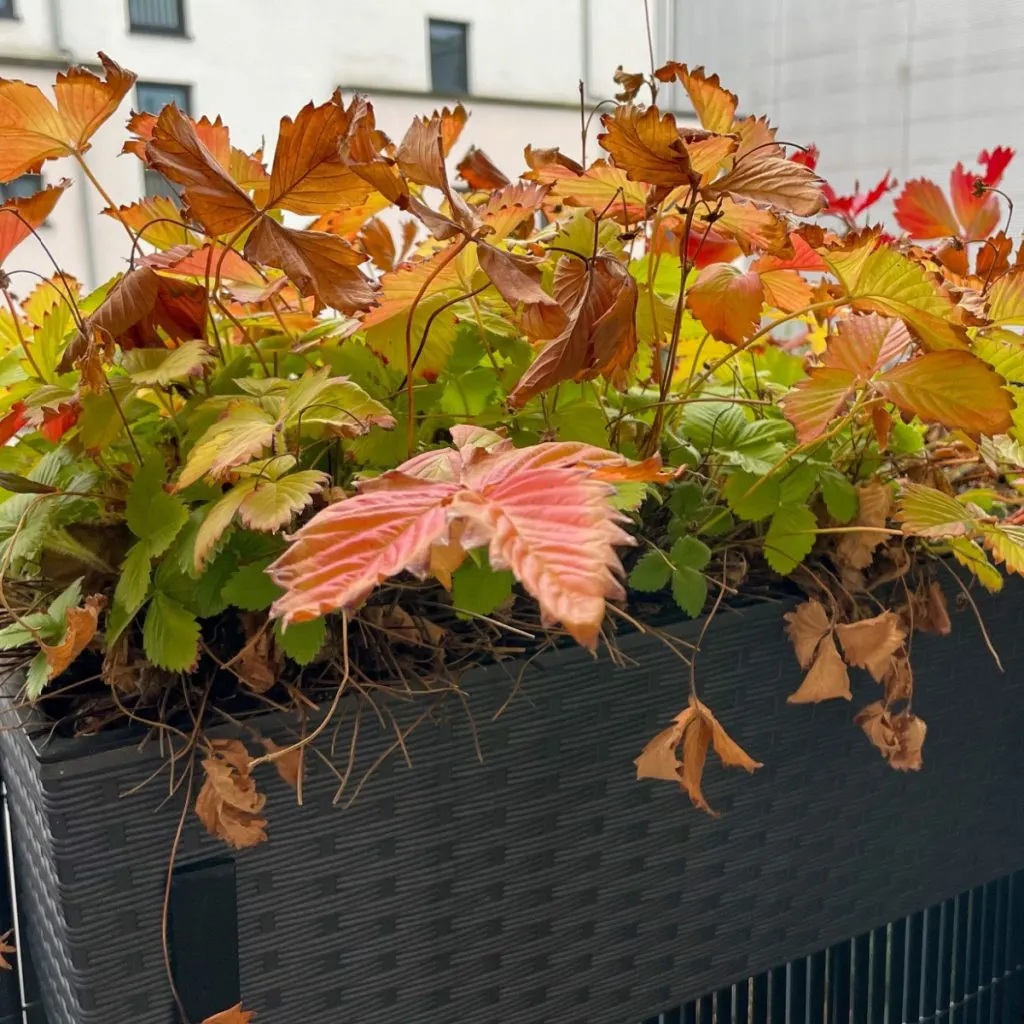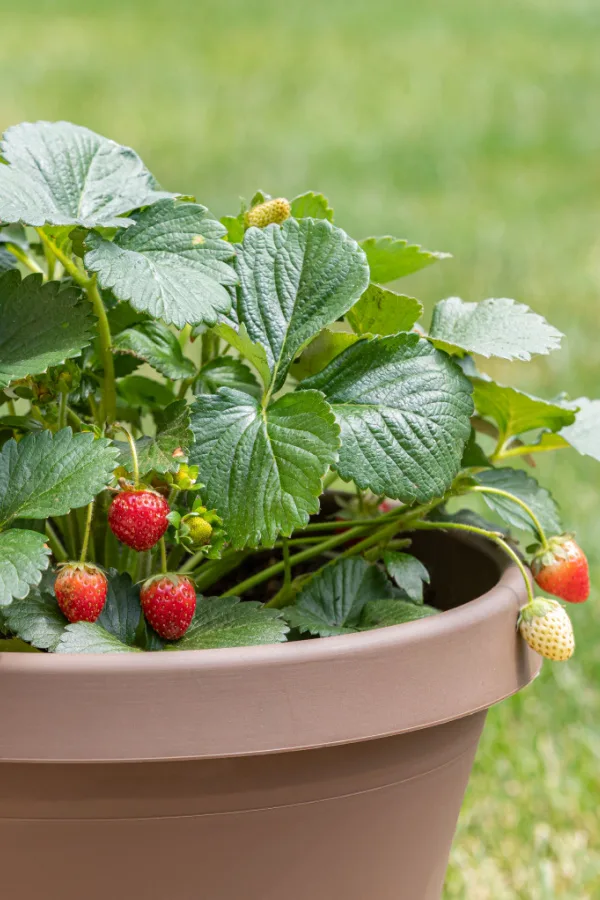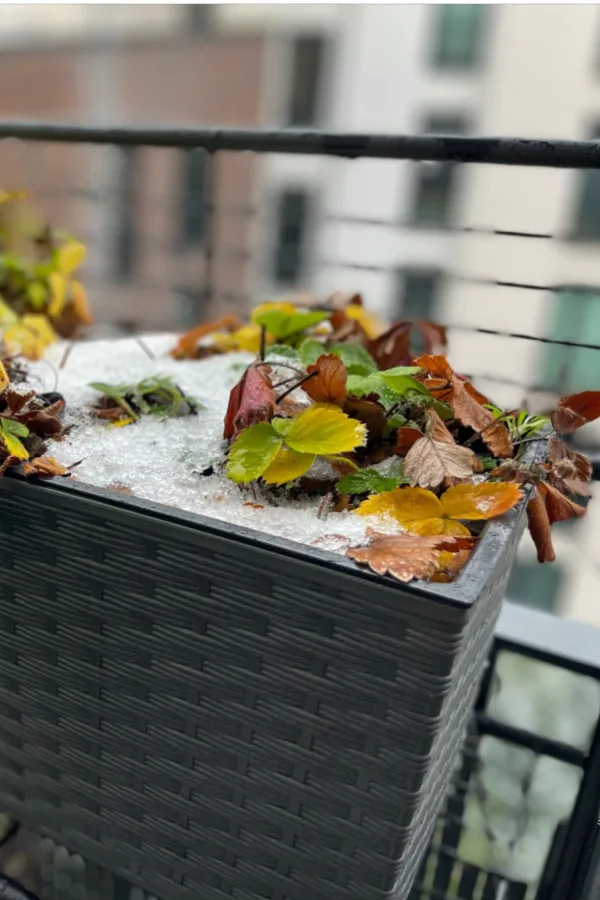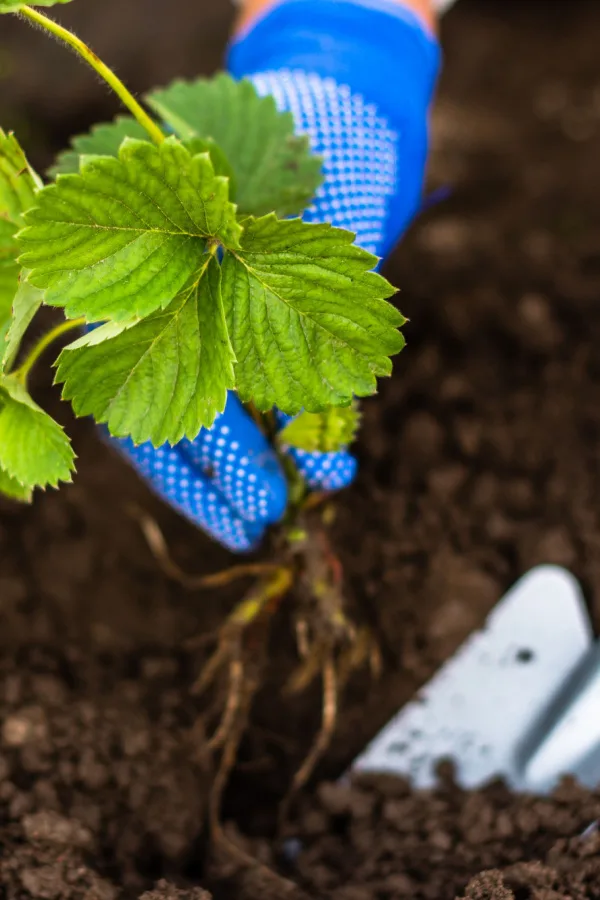Looking for how to prepare your potted strawberry plants this fall for winter – and keep them alive and healthy for next year? Not only is it possible to save strawberry plants growing in pots over long & frigid winters, it’s easier than you might think!
Not everyone has the space or yard to dedicate to a large strawberry patch or even a small raised bed. But that is where pots and containers save the day. Not only are potted strawberry plants easy to plant and grow, they also tend to suffer less from pests, insects, and disease than in-ground plants.
But if there is one issue with strawberries growing in containers, it’s how to care for them over the winter. One thing is for sure, without the protection of the ground, they can freeze out quickly!

Without a bit of assistance when it comes to winter protection, strawberry plants and their autumn-formed buds can easily become damaged or even killed by hard frosts and freezes. As can the entire plants if the roots freeze out. This is especially true when growing in USDA Zones 5 and further North.
The good news is that protecting your plants isn’t difficult, it just requires a little work in the fall to prepare them properly for the upcoming cold!
How To Prepare Potted Strawberry Plants For Winter
Step 1 – Avoid Pruning!
While pruning strawberry plants is a great way to tidy up and re-energize plants, it is always best to avoid doing it during the fall. Just as with some bushes, shrubs and other perennials, you can actually cause more damage than good when you do a fall pruning.
As mentioned above, strawberry plants have already started to create their buds during the fall months. Pruning plants late in the season will eliminate all of that new growth and bud formation. This causes a reduction in fruit when spring rolls around.
In addition, pruning plants in the fall will leave the plants even more exposed to harsh winter conditions. This will likely leave your plants vulnerable and at a higher chance of being killed by inclement weather. Especially when it comes to plant in pots.

Because of this, strawberry plants should never be pruned during the fall as part of a winterizing process. Instead, be sure to prune right as soon as plants have finished producing fruit in early or late summer. This timing will depend on the variety.
How To Protect Pots As Winter Approaches
When plants are not grown directly in the soil, their foliage and roots are more exposed to colder temperatures. That cold air can easily circulate around thin containers, threatening the health of delicate roots.
There are actually several different ways you can protect berries growing in pots. The real key is to allow the potted plants to stay cool enough to go into dormancy and gear up for a fruitful spring growing season.
Method 1: Burying Plants In The Ground – Preparing Potted Strawberry Plants For Winter
One of the best ways to protect potted strawberry plants is to bury the pots directly into the ground.
This allows the ground to do the bulk of the winter protection for you. It’s also a great option for people who have already cleared out their summer garden or raised beds and have extra open space.

You can actually leave the strawberries in their pot and literally “plant” them into the ground – container and all. This works best with plastic containers as opposed to clay or terracotta. These types can crack and break during hard freezes or when the ground freezes and thaws repeatedly.
To plant containers, simply dig a hole that is about an inch wider and deeper than your container. Place the strawberries and the pot in the ground. Keep the top of the pot level with the top of the soil. Fill any gaps around the container with soil.
To finish, cover the pot and plants with a thick layer of natural mulch. Apply about half a foot or so once the frosts arrive and plants have become dormant. Straw, shredded leaves, grass clippings, and pine needles are all great natural resources to use as mulch. See: How To Use Pine Needles To Protect & Power Strawberries In The Fall

Method 2: Relocating Containers – Preparing Potted Strawberry Plants For Winter
If ground planting isn’t an option for you, another great option is moving the plants to a safer location. One thing you don’t want to do is bring your plants into your home so they stay nice and toasty. Strawberry plants actually need colder temps to stay dormant for a period of time.
To do this, you can move the pots to unheated locations on your property that provide a bit more protection from winter’s elements. Any outbuilding such as a shed or barn works great for this as long as it’s unheated. Even an unheated garage works well.
Along with moving the containers to protected areas, you need to take a few additional steps to help them overwinter in most instances.
If the strawberry containers fit, you can place them into a 5-gallon bucket or a large tote and then heavily mulch to fill the empty spaces. You can also place containers into heavy burlap sacks and mulch around the open space there as well.

Another option is to use bales of straw to help protect exposed pots. Place the bales around containers as close as possible to act as insulation. Be sure to add additional mulch around any of the open spaces and mulch on top of plants as well. This is a perfect method if overwintering strawberry pots in a barn.
Watering In The Winter – Preparing Potted Strawberry Plants For Winter
Keep in mind that although strawberry plants will go dormant in the winter, they will still need water in order to survive. This is especially true for pots or container plants that you have moved to protected locations.
Those that have been transplanted in the soil with their container should receive sufficient watering through rainfall and snow melt. The addition of mulch will also help them to retain moisture as well.
Be sure to check plants weekly and water only when needed. Do not over-saturate the soil. Just keep it just slightly damp. Usually, providing water every few weeks will do the trick.
After Winter Care – Preparing Potted Strawberry Plants For Winter
After the threat of frost has passed and the days start to warm up, it’s time to get your strawberry plants ready for spring again.
For strawberries that you planted in the ground, keep any mulch you added onto plants as long as possible to keep them protected. Once you start to see the start of new growth, the mulch can then be removed.
As soon as the ground thaws out and is workable, you can dig up the containers. Be sure to remove any excess soil. Move the containers to a sunny location to promote new growth and prepare for fruiting.
With plants that you have stored in unheated outbuildings, start to bring them outside as soon as the weather allows. You can do this slowly for a few hours at a time just as you would when hardening off flower or vegetable transplants.
Before you know it – your strawberry plants will be producing again!
Simple Garden Life
Follow Our Facebook Page For Even More Great Tips! Simple Garden Life Facebook Page
Simple Garden Life is a website dedicated to keeping gardening fun, simple and enjoyable! We publish two new articles each week along with a new garden podcast episode every two weeks. This article may contain affiliate links.
